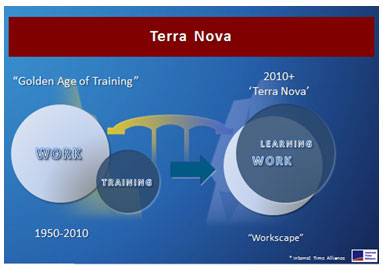The Internet Time Alliance continue with the penultimate part of their series on social learning, this time putting the modern idea of networking in the context of industrial and economic history.
Getting things done in networks
England's New Forest is called 'new' because it was built in 1079 by that well-known Johnny-Come-Lately, William the Conqueror. William wanted an oak forest for hunting. Timber would be required for building ships centuries later. He was thinking long term; let's follow his example.
Free yourself from day-to-day worries for a few minutes, and join us for a tour of the learning landscape five years hence, in 2015. We will call our destination Terra Nova, Latin for 'new world'. Within five years, the world will have changed so radically, you will not recognise it. It is a new era and it is right around the corner.
- Agricultural age: manual labour by individual farmers, 8,000 BC
- Industrial age: machine-assisted manual labour in factories, 1760
- Information age: white-collar knowledge work in offices, 1949
- Terra Nova: creative collaborative innovation in networks, 2012
In the industrial age, bosses issued instructions and told workers they were not paid to think. (We use the term 'workers', not 'learners', because work is their ultimate goal; learning is simply an enabler). This is the ultimate in 'push', for people deal with what is pushed upon them.
In the information age, people were encouraged to think, but only 'inside the box', that is, complying with narrow sets of procedures and rules. Workers were empowered - within strict bounds. Assignments still drifted down from the top. This is still primarily 'push'.
In Terra Nova, 'push' and 'pull' combine to create a dynamic flow of power, authority, know-how, and trust. Change is so fast and furious that work and learning blur into one activity. Workers respond to novel situations as best they see fit, governed by organisation values and gut feel.

Terra Nova is holistic, with significant decision-making power delegated to the workers themselves. 'power to the people' could be its rallying cry.
The industrial age was top-down, explicit, and focused on efficiency. By contrast, Terra Nova supplements hierarchy with networks.
"I love to learn (pull) but I hate being trained (push)" said Winston Churchill.
We're optimistic about Terra Nova: Workers will lead organisations as well as managers and executives. No longer treated as cogs in the machine, people will have the freedom to be all that they can be - and the responsibilities that go with that freedom. Our hive mind will create unparalleled value and fulfilment.
Here are more characteristics for describing the transition from one-way push to two-way pull. The lines between them are fuzzy. Old eras never die; they simply fade into the background. These are inspired by Dan Pink's A Whole New Mind (2006).
Characteristics of Terra Nova | |||
Industrial Age | Information Age | Terra Nova | |
worker | manual labourer | knowledge worker | creative networker |
source of value | hard assets | intellectual capital | design & emotional appeal |
what works | muscle & blood | left-brain logic | right-brain art |
focus of attention | mindless | execution | innovation |
communications media | speech | text | context |
exemplars | factory labour, robber barons | MBAs, lawyers, engineers | inventors, counsellors, entertainers |
workflow | sequential | linear | simultaneous |
Networks and connections exemplify Terra Nova. Networks crave connections. The denser the connections, the faster the cycle time. Time flies by at blinding speed. There's more progress made in one of your minutes than in one of your father's hours. One scientist [1] calculates that the 21st century will contain 20,000 20th-style years!
Isaac Newton gave us a clockwork universe where every action yielded an equal and opposite reaction. René Descartes made the case for pure logic (by taking God out of the equation.) Their world was predictable, precise, and tidy. We felt in control. Logic ruled.
In Terra Nova, everything is relative. As more and more people and entities interconnect, everything flows. Control is an illusion. Complex adaptive systems create butterfly effects [2] all around. In the industrial age, an exemplary worker might produce 25% more than average; now, a great engineer may create 200 times the value of an ordinary engineer. Black swans abound. The insight of a minute may reverberate for decades.
Making progress in this network age requires know-how and the motivation to apply it.
Motivation
People are motivated to do things because they want to make progress [3]. As Dan Pink [4] writes, "It's about satisfying workers' desire for autonomy, which stimulates their 'innate capacity for self direction.'" Some people want to increase the breadth of their repertoire to gain personal power. The best motivation is intrinsic. People do things for their own satisfaction, not external rewards.
The carrot-and-stick method simply doesn't work. In fact, external reward initiatives often backfire. Withdraw the reward and the desired behaviour may stop. Also, rewards tied to performance have the potential to change play into work.
If you set high expectations of people, they usually live up to them. if you have low expectations of people, they live down to them. A person not trusted with the authority to do something can't take responsibility for doing it. "It's not my department." A person authorised and trusted to take responsibility cannot help but do so.
As Will Herzberg, "the father of motivation theory," pointed out years ago [5], workers are motivated by achievement, recognition, the work itself, responsibility, promotion, and growth. This innate desire to do well can be hindered by obstacles that reduce motivation: lack of respect, poor working conditions, perceived unfairness, low pay, lack of job security, and poor relationship with supervisor.
Instructional design pioneer Robert Mager [6] proposed a manner of determining whether a roadblock was inadequate knowledge or lack of motivation. Hold a gun to her head. If she does what you ask, you're grappling with a motivation problem.
citations:
1 Kurzweil, R. (2006) The Singularity is Near
2 Lorenz, E. "Does the flap of a butterfly’s wings in Brazil set off a tornado in Texas?"
3 Amabile, T. Creativity, Improvisation, and Organizations, Harvard Business School Case Notes, 2009.
4 Pink, D. 2010. Drive, the Surprising Truth About What Motivates Us
5 Herzberg, W. 1968. One More Time, How Do You Motivate Employees? Harvard Business Review
6 Mager, R. 1970. Analyzing Performance Problems. Or You Real/y Oughta Wanna. Fearon Publishers
2 Lorenz, E. "Does the flap of a butterfly’s wings in Brazil set off a tornado in Texas?"
3 Amabile, T. Creativity, Improvisation, and Organizations, Harvard Business School Case Notes, 2009.
4 Pink, D. 2010. Drive, the Surprising Truth About What Motivates Us
5 Herzberg, W. 1968. One More Time, How Do You Motivate Employees? Harvard Business Review
6 Mager, R. 1970. Analyzing Performance Problems. Or You Real/y Oughta Wanna. Fearon Publishers
This article was excerpted from 'The Working Smarter Fieldbook' (September 2010 Edition) by Jay Cross, Jane Hart, Jon Husband, Harold Jarche, Charles Jennings and Clark Quinn of the Internet Time Alliance









